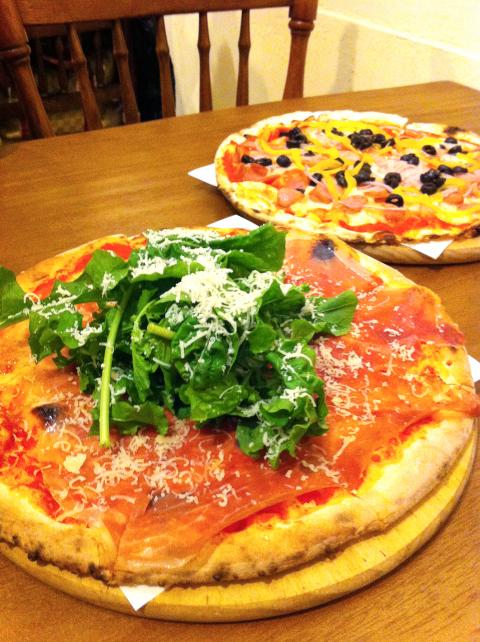The queues that regularly form outside Pizzeria Oggi, which opened three months ago, speak volumes about the effort and forethought that went into the restaurant.
One of Pizzeria Oggi’s main attractions becomes apparent before entering the building: through the storefront window a group of men, all wearing immaculate chef whites, can be seen working the large wood-fired oven in the restaurant’s open-plan kitchen.
Leading the pack is proprietor, renowned chef and cookbook author Tom Hsieh (謝宜榮), whose resume includes stints at several five-star hotels in Taipei.

Photo: Ho Yi, Taipei Times
His newest gastronomic venture boasts a simple, well laid-out menu featuring two types of pies: thin crust Roman pizzas and Neapolitan pizzas.
Authenticity tops Hsieh’s list of ingredients for a successful restaurant. The oven, which is fueled by acacia wood, was built by the family-run Acunto Forni company of Naples, and the pizza dough is made with premium flour from Italy’s Molino Caputo, said to be one of the world’s best pizza flour makers. Food critics and bloggers have been raving about the chef’s plan to become the country’s first pizzeria to be certificated by the Vera Pizza Napoletana Association in Naples.
But does the food live up to the hype? We tried the restaurant’s signature Napoli pizza, which was topped with mozzarella, prosciutto, Grana Padano and arugula (NT$530), and were instantly won over by the union of the meat’s saltiness and the fresh arugula’s nutty and bitter flavors. A couple of drops of balsamic vinegar take the edge off the rocket’s bitter notes and add a whole new dimension to the pie. Equally as pleasing as the toppings was the springy and chewy Neapolitan crust, which is baked at a higher temperature and more quickly than its Roman cousin.
From the Neapolitan section, the efficient waitstaff recommends the quattro formaggio (NT$420), which is topped with fresh mozzarella, pepper jack, gorgonzola, smoked cheese, walnut and honey. A more innovative topping combination is the smoked duck with mozzarella and spring onion from Yilan (NT$390).
From the selection of Roman pizzas, we picked the Bologna sausage version with anchovy, Danish mozzarella, black olives, bell pepper and onion (NT$450), but found the thin crust quickly became soggy, and the anchovies weren’t distributed evenly. A popular choice from the Roman selection is the Hawaiian (NT$350), topped with Danish mozzarella, ham, black olive, onion and homemade dried pineapple.
Though the pizzas demand star billing, Hsieh’s exciting antipasti offerings shouldn’t be overlooked. The dish of mushrooms with balsamic vinegar and olive oil (NT$160) is tantalizingly aromatic, and the prosciutto with locally grown figs (NT$250) strikes a stimulating salty-sweet savor.
The pizzeria stocks a selection of drinks that includes bottled Belgian, Italian and Japanese brews (NT$120 to NT$200), honey with fig vinegar (NT$100), and Lambrusco (NT$600 per bottle).
With its cozy interior, Pizzeria Oggi is a good choice for catching up with friends over a satisfying and relaxing meal. The restaurant is located near the intersection of Dexing West Road (德行西路) and Zhongshan North Road (中山北路).

This month the government ordered a one-year block of Xiaohongshu (小紅書) or Rednote, a Chinese social media platform with more than 3 million users in Taiwan. The government pointed to widespread fraud activity on the platform, along with cybersecurity failures. Officials said that they had reached out to the company and asked it to change. However, they received no response. The pro-China parties, the Chinese Nationalist Party (KMT) and Taiwan People’s Party (TPP), immediately swung into action, denouncing the ban as an attack on free speech. This “free speech” claim was then echoed by the People’s Republic of China (PRC),

Exceptions to the rule are sometimes revealing. For a brief few years, there was an emerging ideological split between the Democratic Progressive Party (DPP) and Chinese Nationalist Party (KMT) that appeared to be pushing the DPP in a direction that would be considered more liberal, and the KMT more conservative. In the previous column, “The KMT-DPP’s bureaucrat-led developmental state” (Dec. 11, page 12), we examined how Taiwan’s democratic system developed, and how both the two main parties largely accepted a similar consensus on how Taiwan should be run domestically and did not split along the left-right lines more familiar in

Specialty sandwiches loaded with the contents of an entire charcuterie board, overflowing with sauces, creams and all manner of creative add-ons, is perhaps one of the biggest global food trends of this year. From London to New York, lines form down the block for mortadella, burrata, pistachio and more stuffed between slices of fresh sourdough, rye or focaccia. To try the trend in Taipei, Munchies Mafia is for sure the spot — could this be the best sandwich in town? Carlos from Spain and Sergio from Mexico opened this spot just seven months ago. The two met working in the

Many people in Taiwan first learned about universal basic income (UBI) — the idea that the government should provide regular, no-strings-attached payments to each citizen — in 2019. While seeking the Democratic nomination for the 2020 US presidential election, Andrew Yang, a politician of Taiwanese descent, said that, if elected, he’d institute a UBI of US$1,000 per month to “get the economic boot off of people’s throats, allowing them to lift their heads up, breathe, and get excited for the future.” His campaign petered out, but the concept of UBI hasn’t gone away. Throughout the industrialized world, there are fears that